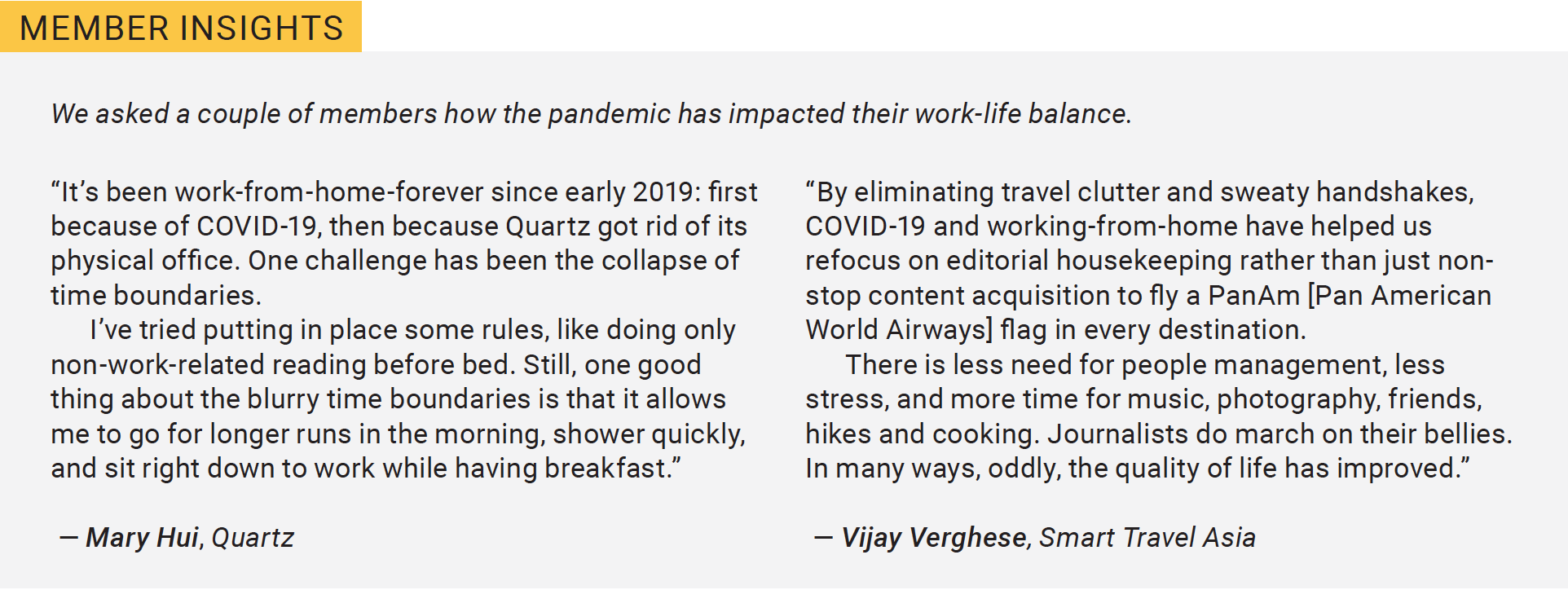
How COVID-19 Has Impacted Hong Kong Media
As Rick Boost discovers, the pandemic has pushed many media organisations in Hong Kong to adjust workplace policies, find new revenue streams and come out stronger.
When COVID-19 swept across the globe in early 2020, it pummeled many media companies. Some slashed freelance budgets, others cut staff, closed offices and reduced nonessential spending.
Here in Hong Kong, we’ve witnessed mass staff layoffs and office closures – as seen at i-Cable and Quartz, respectively – as well as radical shifts in how teams work together. Nearly two years on, media companies in Hong Kong have found some footing, but the ground continues to shift.
“In early 2020, no one could have foreseen the impact that COVID would have on our personal and professional lives and changed the ways we live, work and interact,” says Atifa Silk, the Asia managing director of Haymarket Media.
“We had to adapt quickly and, thankfully, most of our people were able to embrace the changes and reap the rewards that working from home can bring.”
 Entertainment and media revenue in Hong Kong plummeted 11.8 percent, or US$1 billion, in 2019, according to PWC.
Entertainment and media revenue in Hong Kong plummeted 11.8 percent, or US$1 billion, in 2019, according to PWC.The great migration
In early 2020, the government appealed to employers to allow staff to work from home to minimise social contact. Many Hong Kong media companies, including Haymarket, swiftly instated mandatory work-from-home (WFH) policies and entered a period of trial-and-error.
While Haymarket identified many benefits with remote work – more efficient meetings, fewer distractions, no commutes, time with family – they encountered a fair share of hurdles, too. “The sparks of creativity that happen in face-to-face conversations are hard to replicate virtually,” says Silk. “There can be fewer opportunities for immediate support and training for young talent. And there is the pressure of feeling like you’re always on – that lack of separation between work and home life can impact wellbeing and mental health.”
In September 2020, Haymarket conducted a company-wide survey on flexible work, asking staff: “Would you value the option to work from home one to two days a week?” Roughly 96 percent of staff in Asia responded positively. So, in November 2020, the company began piloting a flexible work model that encouraged employees to work from home. Since moving into a new office in Sheung Wan in August 2021, the company has refined the model. Now, all staff work in the office three days a week – two of which centre around collaborative tasks.
Cliff Buddle, special projects editor at the South China Morning Post and FCC board member, says remote work shook up the legacy publication. “For the first time in our history, we produced a newspaper with no editorial staff in the newsroom,” he says. “This was done at very short notice when our office temporarily closed. It was an impressive achievement, given that print publication requires much collaboration.”
Nick Thorpe, the East Asia director of media intelligence platform Telum Media, says many media companies in Asia had resisted the move toward remote work before the pandemic due to a “complex web of cultural and social hurdles”.
“Some staff had never worked from home before and found the prospect so alien – both due to traditional workplace structures and small apartments,” he continues.
“Some [people] opted to remain office-based even at the height of the pandemic, while others have barely been into the office for 18 months.”
By contrast, some young, nimble companies like Liv Media have long preferred flexible work models, encouraging employees to work remotely since launching its flagship, Liv magazine, in 2015.
“While there is a slight tradeoff in efficiency, we have seen great staff retention and overall employee satisfaction as people feel they have more control over their lives,” says Sarah Fung, Liv Media’s founder and publisher. “Productivity isn’t measured by a punch card – if you have good employees, you can trust them to manage their own schedules.”
5 Media Trends to Watch
- Remote Work: WFH will become an acceptable, and expected, aspect of employment.
- Health and Safety: Wellbeing in all its many guises will be an essential part of any work contract.
- Audiophilia: Podcasts are commanding more and more attention.
- New Revenue Streams: With so much free content on offer, media must look to value-added services.
- Social Media+: Instagram, Facebook, Twitter and their progeny will command ever greater importance.
 During the downturn, Liv Media publisher Sarah Fung looked to new revenue streams such as awards, supplements and content creation.
During the downturn, Liv Media publisher Sarah Fung looked to new revenue streams such as awards, supplements and content creation.Revising revenue streams
COVID-19 exposed the vulnerabilities of many industries – and media was not spared. In its “Global Entertainment and Media Outlook 2020-2024: Hong Kong Summary”, PricewaterhouseCoopers (PWC) reports that entertainment and media revenue in Hong Kong plummeted 11.8 percent, or US$1 billion, from US$8.5 billion in 2019 to US$7.8 billion in 2020.
“Hong Kong revenue was the worst-hit compared to global and Asia-Pacific markets,” states the report. The study also found that newspapers, magazines, and online advertising markets shrank, while video games, podcasts and over-the-top video services (such as Netflix or Hulu) grew.
“The pandemic has created a challenging environment for news organisations around the world,” Buddle adds. “The economic impact has hit advertising revenues, exacerbating problems newsrooms were already facing in finding new income streams and operating models. Those challenges will continue, although there are signs of improvement in Hong Kong as social-distancing restrictions are lifted.”
Organisations like Liv Media also felt the squeeze. “Lifestyle media budgets have been affected massively,” says Fung. “When the pandemic hit, our core sales categories – hospitality, travel and tourism, food, beverage and gyms – completely disappeared.”
During the downturn, Liv Media changed its strategy to look beyond traditional advertising. A significant portion of the brand’s revenue now comes from events, awards, guides, supplements, and bespoke content creation.
Fung also rolled out a free subscription service for readers and increased Liv magazine’s distribution network to 500 points across Hong Kong. These strategies – combined with the return of traditional ad spending – have put Liv in a stronger position for growth post-pandemic, she adds.
Haymarket also regrouped and pivoted. According to Silk, the company evaluated its operations, portfolio and services. For example, Haymarket conducted market research on the finance and marketing-communications industries, including qualitative interviews with readers and clients to better understand their needs.
The company also expanded its content solutions arm, leaned into subscription models and shifted its content strategy, adopting new tools, such as the digital storytelling platform Shorthand, to boost audience engagement.
“We challenged ourselves to think differently about our audiences and platforms,” says Silk. “The reset enabled us to reshape the Asia business and transform our revenue and financial profile, giving us a clear focus on building digital-first ideas and solutions.”
PWC’s more recent outlook, published in July, seems more optimistic. The report anticipates a 7.65 percent rise in Hong Kong’s 2021 entertainment and media revenues, from US$7.8 billion in 2020 to a projected US$8.4 billion in 2021.
Fung says she’s seen some renewed momentum on the sales front. “We’ve found that clients are starting to come back,” she says. “I think they’re tired of waiting for the pandemic to end and have realised that they need to keep marketing through the ‘new normal’.”
 Many companies have leaned into digital-first storytelling.
Many companies have leaned into digital-first storytelling.Evolving career paths
Though the employment market for media professionals seemed dire this time last year, job openings in the industry seem to be picking up again. Thorpe says he’s observed exponential growth in the number of roles posted across Asia on Telum’s online Jobs Board.
“We’ve seen a lot of media outlets subsequently bounce back and kick-start hiring again, with digital and video journalism seeing a particular focus alongside more traditional reporting roles,” he says.
But now, publishers and editors prefer new hires to be just as diverse as their new revenue streams. “There’s probably not as much of a career path for someone who is just a writer post-COVID-19,” says Fung. “Employers are looking for media professionals with lots of strings in their bow, whether that’s graphic design, SEO, social media, photography or paid content creation.”
Thorpe broadly agrees, adding that the global crisis has shaken up traditional career paths in media. The pandemic – combined with a wealth of content creation channels online – has enabled many people with multimedia skills, like podcasting or video production, to break into the industry.
Thorpe expects that aspiring and existing media professionals alike will likely need to gain new skills in order to keep up. “There has been an explosion in media brands seeking experts in data, social media, video journalism, digital content creation and so on,” says Thorpe. “And of course, every media brand is looking at audio content today – there’s a gold rush in podcasting right now that shows no sign of slowing any time soon.”
Post-COVID Skill Set
Employers are increasingly seeking enhanced skills such as:
- Video production
- Audio production
- Livestreaming
- Graphic design
- Social media skills
- Writing for new media formats


Rick Boost is a born and raised Hongkonger. He has overseen copy and multimedia content at several of the city’s media outlets, including as HK Editor of Marketing Magazine/Interactive.




















